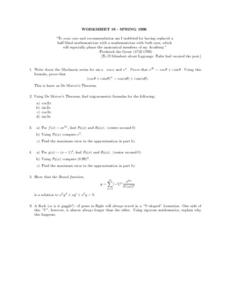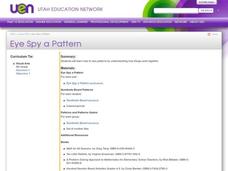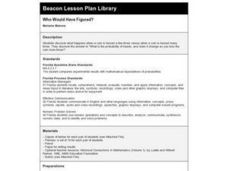EngageNY
Applications of the Pythagorean Theorem
Examine the application of the Pythagorean Theorem in problem-solving questions. Pupils apply the theorem to find lengths when given different scenarios. They finish the 17th installment in an 18-part series by applying the theorem to...
Curated OER
Worksheet 19-Spring 1996
In this math worksheet, students begin with the Maclaurin series and prove De Moivre's Theorem. They use the De Moivre Theorem to solve four problems. Students apply these theorems to explain why a flock of geese will fly in an uneven...
Curated OER
Location
Students explore the tools used by Columbus to chart his latitude. They study the change of a location over time.
Curated OER
Dude, Where's My Karma?
Students research various aspects of Indian culture. They create a Book of Knowledge about India. In a second activity they research the history behind any game. They make presentations and play the different games during Game Day.
Curated OER
Sieve of Eratosthenes
Students discover the Sieve of Erathosthenes. They explore a method to find all the prime numbers in a group of numbers. Using models, students practice divisibility rules while examining the difference between prime and composite numbers.
Curated OER
African Americans in Science
Students explore the careers of prominent African Americans in science, mathematics, and technology. They use The Faces of Science: African Americans in the Sciences website, which includes profiles of past and present African Americans...
Curated OER
Eye Spy a Pattern
Fifth graders identify patterns by understanding how things work together.
Curated OER
Eye Spy a Pattern
Fifth graders examine how to see patterns by showing how things work together. They identify, analyze and determine a rule for predicting and extending numberical patterns involving operations of whole numbers, decimals and fractions.
Curated OER
Exploring Special Lines
Learners compare and order numbers. In this geometry lesson, students write equations for inequalities. They differentiate and apply concepts of triangular properties to solve problems.
Curated OER
Mapping Data Made Manageable
Students explore how to select unbiased random samples as they choose report data to include on maps. They propose methods for choosing random numbers and discuss their advantages and disadvantages. They consider bias in science.
Curated OER
The King's Slice
Students participate in an experiment involving the square root of two. They use different methods to solve the problem.
Curated OER
Time Travel
Students investigate the concept of time travel and quantum physics. They complete a Webquest, read excerpts from the book, 'The Time Machine,' play an online time traveler game, and read and evaluate newspaper articles about time.
Curated OER
Egyptian Fractions
Sixth graders take a brief look at what is known about Egyptian Fractions. These are unit fractions - fractions whose numerator is one. We look at how fractions can be represented in terms of Egyptian Fractions. Finally we suggest a web...
Curated OER
The Helenistic Age and the Legacy of Alexander
Eighth graders describe, analyze and evaluate the history of ancient Greece from 2000 to 300 B.C. They explore the influence of geography on Greek economical, social, and political development.
Curated OER
Who Would Have Figured?
Students investigate what happens when a coin is tossed a few times versus many times. They analyze, in groups, the data from tossing coins, and the Law of Large Numbers.
Curated OER
Richard's Dice
Students problem solve logic problems. They complete a worksheet using dice as a manipulative. They decide on a problem solving strategy, solve the problem, and write up the solution.
Curated OER
African Americans in Science
Learners examine the life of renowned African American scientists. In this science literacy instructional activity, students explore a website containing profiles and achievements of past and present African American scientists. They...
Science Buddies
Science Buddies: Tiling With Spidrons
If art and math are both passions of yours, this project is meant for you! Spidrons are geometric forms made from alternating sequences of equilateral and isosceles (30 degrees, 30 degrees, 120 degrees) triangles. Spidrons were...
Other popular searches
- 5 Great Mathematicians
- Five Great Mathematicians
- The Great Mathematicians
- List of Great Mathematicians
- Hall of Great Mathematicians
- About Great Mathematicians
- 5 Great Mathematicians Photo
- Hal of Great Mathematicians
- Names of Great Mathematicians



















